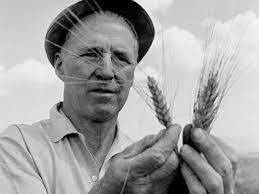The America most prominent legend Who Disarmed the Populace Explosive
Categories: science education

TheAmerica's most prominent legend Who Disarmed the 'Populace Explosive'
Dr.Borlaug's abilities as a competitor (essentially in wrestling) opened the entryway for him to goto the College of Minnesota, where he examined to be a forester, wrestled, andworked different random temp jobs. Subsequent to graduating in 1937 with a BSin Ranger service, he went to work for the US Woods Administration, at first inIdaho and later in Massachusetts and Connecticut. He got back to graduateschool at the College of Minnesota, and took up the investigation of plantpathology, accepting his Ph.D. in 1942. Years after the fact, the Collegeof Minnesota would house its plant pathology and agronomy programs in BorlaugLobby.
The 1970Nobel Council picked well. Borlaug was on the double a direct rancher anda splendid researcher who acted with understanding, knowledge and furiousassurance.
Youthfulresearchers working with and for Norman Borlaug in the Mexican wheat programfound it was exceptionally requesting, testing, at the end of the dayfulfilling. Working for and with Borlaug was once in a while depicted as, "atthe same time being in the Harmony Corps and in a Marine Corps trainingcamp."
He acceptedprofoundly in schooling and that training ought to be a worldwide need,particularly the schooling of ladies. He was likewise worried aboutcontamination, the safeguarding of wild regions and keeping up with hereditaryvariety of plant species. His messages to the world were an equilibrium betweenexcitement and wariness.
Wanting tospread high return horticulture to the world's poor, in 1943 Borlaug moved tocountry Mexico to lay out an agrarian examination station, supported by theRockefeller Establishment. Borlaug's little examination station turned into theWorldwide Maize and Wheat Center, known by its Spanish shortening CIMMYT, thatis presently one of the globe's most significant farming review offices. AtCIMMYT, Borlaug fostered the high return, low-pesticide "overshadow"wheat whereupon a significant part of the total populace presently depends forfood. In 1950, as Borlaug started his work vigorously, the world created 692million tons of grain for 2.2 billion individuals.
Hungerdeclined in a state of harmony: From 1965 to 2005, worldwide per capita food utilizationrose to 2,798 calories day to day from 2,063, with the majority of theexpansion in emerging countries. In 2006, the Unified Countries Food andHorticulture Association pronounced that unhealthiness remains "at themost minimal level in mankind's set of experiences," in spite of theworldwide populace having trebled in a solitary hundred years.
"ThePopulace Bomb,"in which he guaranteed that worldwide starvation was unavoidable for the 1970sand it was "a dream" that India would "ever" feeditself. All things considered, in something like three years of Borlaug'sappearance, Pakistan was independent in wheat creation; in no less than sixyears, India was independent in the development, everything being equal.
After hisvictory in India and Pakistan and his Nobel Harmony Prize, Borlaug went tobringing crop yields up in other unfortunate countries particularly in Africa,the one spot in the reality where populace is rising quicker than ranchcreation and the last station of means horticulture.